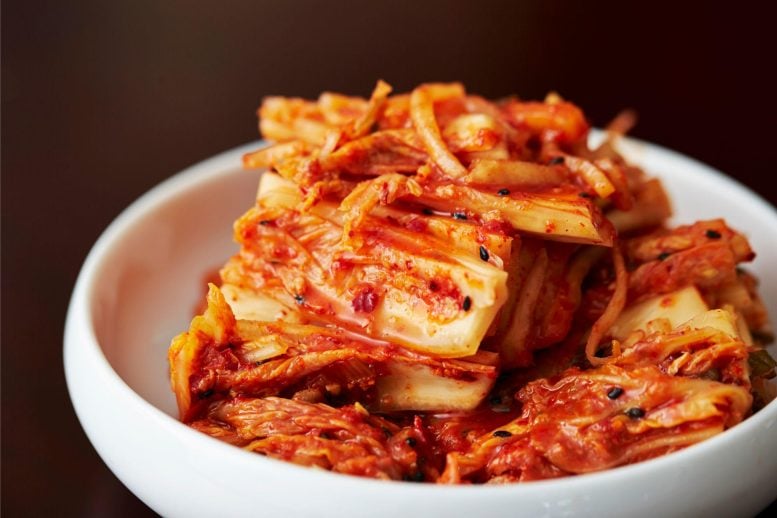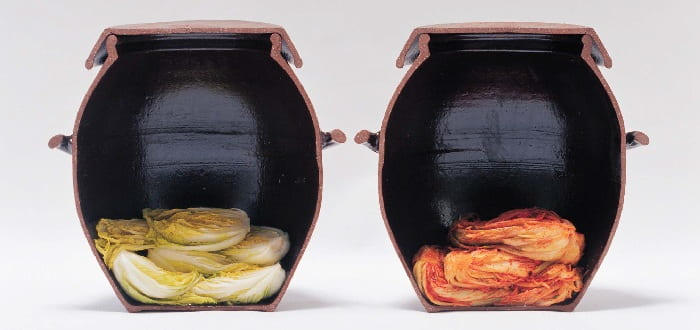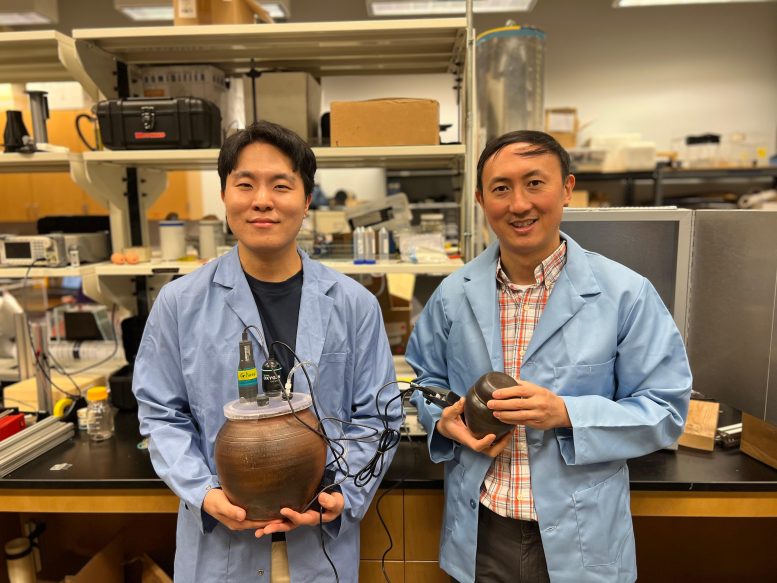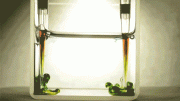
Kimchi is a traditional Korean dish made from fermented vegetables, typically cabbage and radishes, seasoned with various spices and seasonings. It is known for its distinctive tangy and spicy flavor, resulting from the fermentation process. Kimchi is a staple in Korean cuisine and is often consumed as a side dish or used as an ingredient in other dishes, adding a unique and flavorful element to meals.
Kimchi, a type of fermented food, has been a central component of Korean cuisine for millennia. In ancient times, Korean culinary experts utilized onggi, clay jars crafted by hand, for the fermentation of kimchi. While the modern production of kimchi predominantly relies on mass fermentation processes using containers made of glass, steel, or plastic, it’s widely believed that onggi-fermented kimchi boasts superior quality.
This long-held belief among kimchi connoisseurs has now received scientific validation due to recent research conducted by David Hu, a professor at the George W. Woodruff School of Mechanical Engineering at Georgia Tech, along with Soohwan Kim, a Ph.D. student currently in his second year under Hu’s guidance.
In a combined experimental and theoretical study, Hu and Kim measured carbon dioxide levels in onggi during kimchi fermentation and developed a mathematical model to show how the gas was generated and moved through the onggi’s porous walls. By bringing the study of fluid mechanics to bear on an ancient technology, their research highlights the work of artisans and provides the missing link for how the traditional earthenware allows for high-quality kimchi.

A cross-sectional view of onggi showing fermenting cabbage. Credit: Korean Ministry of Culture, Sports, and Tourism.
Their research was published in the Journal of the Royal Society Interface.
“We wanted to find the ‘secret sauce’ for how onggi make kimchi taste so good,” Hu said. “So, we measured how the gases evolved while kimchi fermented inside the onggi — something no one had done before.”
The porous structure of these earthenware vessels mimics the loose soil where lactic acid bacteria — known for their healthy probiotic nature — are found. While previous studies have shown that kimchi fermented in onggi has more lactic acid bacteria, no one knew exactly how the phenomenon is connected to the unique material properties of the container.
First, Kim obtained a traditional, handmade onggi jar from an artisan in his hometown of Jeju, South Korea, a region famous for onggi. Back at Georgia Tech, Hu and Kim first tested the permeability of the onggi by observing how water evaporated through the container over time.

David Hu (right), professor of mechanical engineering at Georgia Tech, and Soohwan Kim, a second-year Ph.D. student, with the onggi they used in fermentation experiments. Credit: Georgia Institute of Technology
Next, they installed carbon dioxide and pressure sensors into both the onggi and a typical, hermetically sealed glass jar. They prepared their own salted cabbage and placed it in both containers. They then used the sensors to measure and compare the change in carbon dioxide — a signature of fermentation.
Hu and Kim also developed a mathematical model based on the porosity of the onggi. The model allowed them to infer the generation rate of carbon dioxide, since the onggi lets carbon dioxide out gradually.
They concluded that the onggi’s porous walls permitted the carbon dioxide to escape the container, which accelerated the speed of fermentation. The onggi’s porosity also functioned as a “safety valve,” resulting in a slower increase in carbon dioxide levels than the glass jar while blocking the entry of external particles. Their data revealed that the carbon dioxide level in onggi was less than half of that in glass containers.
They also found that the beneficial bacteria in the onggi-made kimchi proliferated 26% more than in the glass counterpart. In the glass jar, the lactic acid bacteria became suffocated by their own carbon dioxide in the closed glass container. It turns out that, because the onggi releases carbon dioxide in small rates, the lactic acid bacteria are happier and reproduce more.
“Onggi were designed without modern knowledge of chemistry, microbiology, or fluid mechanics, but they work remarkably well,” Kim said. “It’s very interesting to get these new insights into ancient technology through the lens of fluid dynamics.”
Onggi’s semi-porous nature is unique compared to other forms of earthenware. A clay container that leaks, but only slightly, is not easy to make. Terra cotta containers, for example, quickly leak water.
“It’s amazing that, for thousands of years, people have been building these special containers out of dirt, but in many ways, they are very high-tech,” Hu said. “We discovered that the right amount of porosity enables kimchi to ferment faster, and these onggi provide that.”
Kim said that some artisans still use ancient methods when making onggi, but their numbers are decreasing. Now, the market is flooded with inauthentic versions of the vessels.
“We hope this study draws attention to this traditional artisan work and inspires energy-efficient methods for fermenting and storing foods,” he said. “Also, the onggi are quite beautiful.”
Reference: “Onggi’s permeability to carbon dioxide accelerates kimchi fermentation” by Soohwan Kim and David L. Hu, 5 April 2023, Journal of The Royal Society Interface.
DOI: 10.1098/rsif.2023.0034
The study was funded by the National Science Foundation.









Be the first to comment on "Want Better Kimchi? Scientists Reveal the Secret"